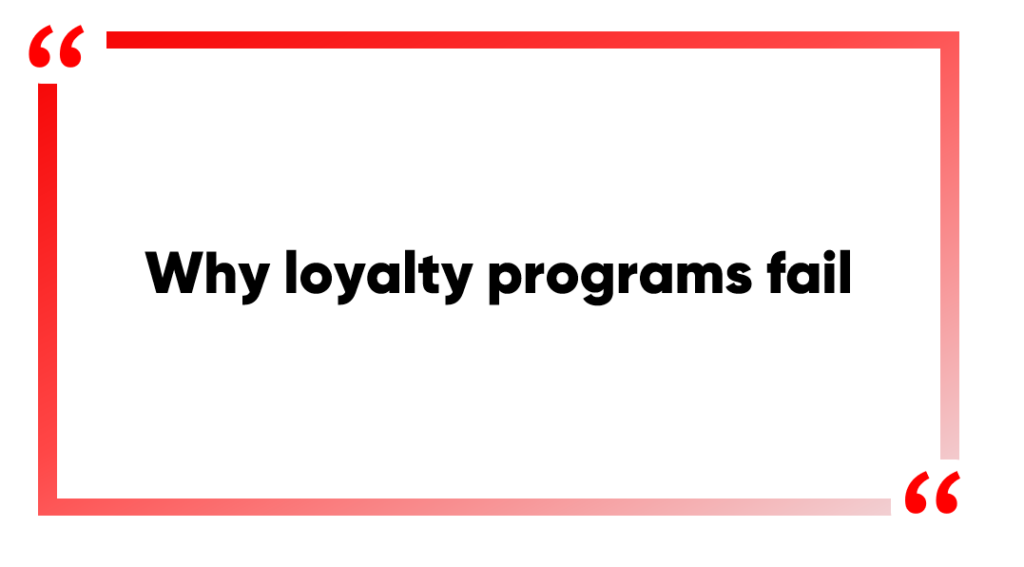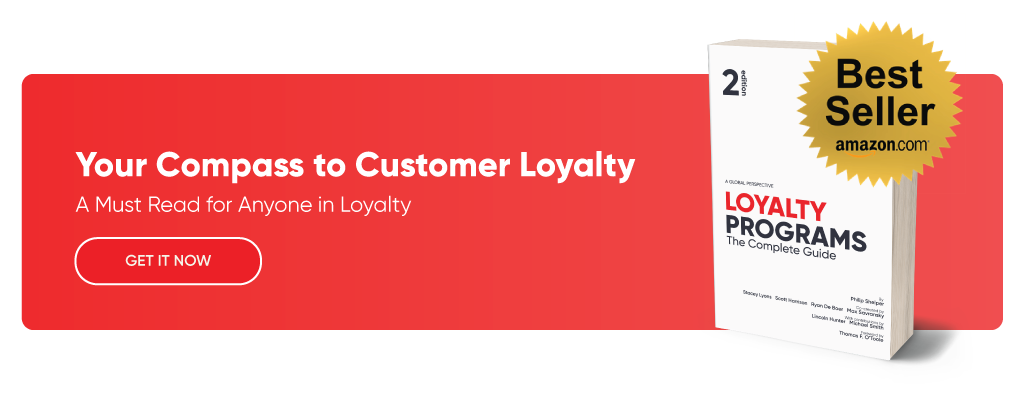
Loyalty programs have become a cornerstone of customer retention strategies across various industries. However, not all loyalty initiatives achieve the desired results, as evidenced by the recent discontinuation of ASOS A-List. This high-profile failure caused a revolution in the loyalty consulting sector, prompting loyalty experts to reevaluate their approach to program design and implementation.
The challenges faced by ASOS A-List are not unique, as other notable programs like Barclays and Lloyds’ Bink and American Express’s Plenti have also struggled to gain traction. To analyze these setbacks, our expert loyalty consultants have analyzed exactly what contributes to program success or failure.
This analysis aims to provide valuable insights for businesses looking to develop or refine their loyalty strategy, with a focus on lessons learned from industry leaders and the guidance offered by specialized firms like Loyalty & Reward Co.
ASOS A-List program lessons

Key features of the program
ASOS A-List utilized a points-based system, offering customers 5 points for every £1 spent. These points were converted into vouchers monthly, with 500 points equating to a £5 off voucher [1]. The program included tiers to reward loyal customers and incentivize increased shopping[1]. Non-monetary rewards, such as early access to sales, were also incorporated to enhance perceived value and potentially increase revenue[1].
Reasons for its discontinuation
Despite its initial promise, ASOS discontinued A-List in October 2018, citing a lack of engagement from the majority of members [2]. The program’s ‘earn and burn’ structure encouraged repetitive shopping behaviors without providing long-term value [2]. Additionally, the scheme’s limitations, such as a 29-day waiting period for point usage and a monthly cap of 5,000 points, may have hindered its effectiveness. [1]
Customer impacts and compensation
The discontinuation affected thousands of customers. As compensation, ASOS offered members a £10 voucher, regardless of their point balance [3]. Existing points were converted into vouchers, with a cap of 3,000 points [3]. Previously earned vouchers remained valid for six months after issuance [3].
Lessons for loyalty practitioners
The A-List program’s failure highlights the importance of engaging customers beyond simple point accumulation. Loyalty experts should consider rewarding engagement alongside expenditure to foster deeper brand loyalty [1]. The program’s complexity and lengthy development time (over 24 months) underscore the need for efficient, adaptable loyalty strategies [1]. Fast fashion retailers must focus on creating genuine, long-term loyalty that goes beyond points and perks [4].
Barclays and Lloyds’ Bink program

Key features of the program
Bink, a loyalty app founded in 2015, utilized Payment Linked Loyalty (PLL) technology to connect consumers’ payment cards with loyalty schemes of partner brands [5]. The app aimed to replace the need for separate rewards cards, streamlining the loyalty process for customers [6].
Reasons for its discontinuation
Despite significant investments from Barclays and Lloyds Banking Group, Bink ceased trading due to financial difficulties. The company suffered substantial losses for several years and failed to secure additional funding [5]. In the year ending August 2022, Bink reported a loss of £11.8 million [6].
Customer impacts and compensation
The closure of Bink resulted in 46 staff redundancies [6]. As the company entered administration, FRP Advisory was appointed to oversee an orderly wind-down of the business [5]. Information regarding specific customer compensation was not provided in the available sources.
Lessons for loyalty practitioners
This case highlights the challenges of sustaining innovative loyalty programs in a competitive market. Despite backing from major banks and a reported valuation of £100 million in 2017, Bink struggled to achieve profitability [6]. Loyalty experts should consider the importance of sustainable business models and adaptability in the face of market challenges.
Amex Plenti program lessons

Key features of the program
Plenti, launched on May 4, 2015, was a coalition loyalty program operated by American Express [7]. It allowed shoppers to earn points through various purchases across multiple retailers [7]. Unlike traditional loyalty programs, Plenti was not tied to a single company or credit card issuer [7]. The program spanned 13 partners with 16 brands by the end of 2016, reaching 71% of U.S. households within a five-mile radius of participating locations [8].
Reasons for its discontinuation
Despite its initial promise, Plenti faced numerous challenges. The program struggled to create personal connections and targeted campaigns [8]. It failed to integrate into brand experiences beyond the surface level, engendering loyalty to the coalition program itself rather than partner brands [8]. In 2017, several partners exited the program, including AT&T, Direct Energy, Hulu, Nationwide, Enterprise, and Expedia [7]. Macy’s departure in early 2018 was a significant blow [8].
Customer impacts and compensation
When Plenti ended on July 10, 2018, all unredeemed points expired [9]. However, some partners offered compensation. Exxon and Mobil replaced unredeemed points with new points in their loyalty program for eligible members [9]. Similarly, BI-LO, Winn-Dixie, Harveys, and Fresco y Mas replaced points earned at their stores with new points in their program [9].American Express continued to protect customers’ personal information in accordance with the Plenti privacy policies [9].
Lessons for loyalty practitioners
The failure of Plenti highlights the importance of creating genuine brand loyalty rather than program loyalty. Loyalty experts should focus on developing brand-aligned and customer-targeted programs [8].The case demonstrates the challenges of sustaining coalition loyalty programs in competitive markets. Future initiatives should prioritize personalization, seamless integration with brand experiences, and clear value propositions for both customers and participating brands.
Designing a successful loyalty program
A successful loyalty program systematically rewards customers for their loyalty, offering both tangible and intangible benefits [10]. It should be data-driven, rewarding the right customers for the right behavior, while remaining profitable [10].An effective program aligns closely with the brand purpose, rewarding actions that reinforce brand values and create business value [10]. It focuses on providing both tangible benefits like cashback and intangible ones such as status and recognition [10]. Simplicity and ease of use are crucial, as is the appropriate use of data to create relevant offers [10]. A loyalty management platform can help launch, manage, and optimize the program [10].
Loyalty & Reward Co’s Essential Eight
Loyalty & Reward Co has developed the Essential Eight™, a set of principles for loyalty program design and optimization [11]. These principles are Simple, Valuable, Stimulating, Emotional, Complementary, Differentiating, Cost-effective, and Evolving [12]. This groundbreaking guide combines insights from academic research, consumer psychology, and industry experience to provide a comprehensive approach to loyalty program development [12].
Conclusion
The failures of loyalty programs like ASOS A-List, Bink, and Amex Plenti offer valuable insights to loyalty practitioners. These cases highlight the importance of creating genuine brand connections, offering clear value propositions, and maintaining sustainable business models. The challenges faced by these programs underscore the need for adaptability, personalization, and seamless integration with brand experiences to foster long-term customer loyalty.
Moving forward, businesses should focus on developing data-driven loyalty strategies that align closely with their brand values and customer needs. By following principles like those outlined in Loyalty & Reward Co’s Essential Eight™, companies can create loyalty programs that are simple, valuable, and evolving. Ultimately, successful loyalty initiatives should go beyond points and perks to build meaningful relationships with customers, driving both engagement and profitability.
References
[1] – https://loyaltylion.com/blog/asos-launches-loyalty-program-asos-a-list
[2] – https://www.ryder.com/en-us/insights/blogs/logistics/revamp-customer-loyalty
[3] – https://www.mirror.co.uk/money/asoss-list-scheme-ending-means-13303970
[7] – https://en.wikipedia.org/wiki/Plenti
[8] – https://www.ebbo.com/insights/blog/why-the-demise-of-plenti-was-inevitable/
[9] – https://www.americanexpress.com/us/legal/plenti/the-plenti-program.html
[10] – https://www.deloittedigital.com/us/en/insights/perspective/customer-loyalty.html
[11] – https://loyaltyrewardco.com/insights/loyalty-programs-the-complete-guide/
[12] – https://loyaltyrewardco.com/essential-eight-guiding-principles-best-practice-loyalty-program/
Is your loyalty program strategy set up for success? Speak to the expert consultants at Loyalty & Reward Co.
Designing an engaging and foolproof loyalty program strategy can be a daunting and complex task without the necessary knowledge or expertise. Contact us today to kickstart your journey towards building a successful loyalty program strategy.
Relevant articles
Click here to view other relevant articles from our expert loyalty consultants on why loyalty programs fail.
- Loyalty programs gone wrong: Cautionary tales and lessons learned by Strategy Consultant, Eli Maynard
- Why do loyalty programs fail? by Program Operations Manager, Vinnie Ward

